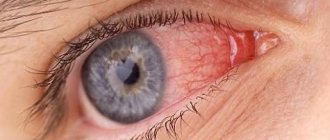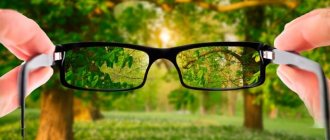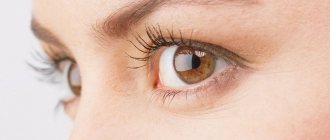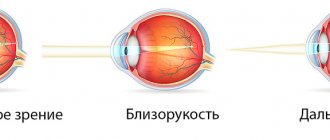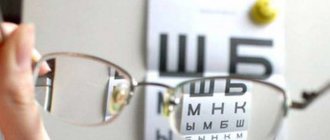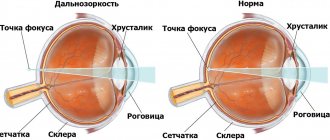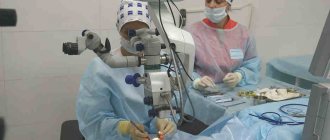With age, any body structure, incl. The biological lens of the eye - the lens and the accommodative apparatus - undergo age-related changes. The muscles of the eye, deprived of adequate loads for them or, conversely, constantly overloaded with monotonous long-term tension, gradually lose strength and contractility. The eye muscles are no exception. With age-related changes in tissues, the firmness and elasticity of the accommodating (focusing) system is gradually lost. The lens also becomes less elastic, the shape of which, during normal vision, is adjusted in such a way that the refraction of light in the eye exactly corresponds to the distance to the object - the closer it is, the more compressed, spherical the natural lens of the lens should be, i.e. the greater the effort required from the ciliary muscle. This phenomenon is called “phacosclerosis”.
It should be noted that in many people, the eyes are initially forced to make somewhat greater efforts than normal: with congenital farsightedness, the ocular muscular system sometimes takes decades to compensate for the optical defect, and a person, without any noticeable problems with vision, is not even aware of the problem . However, as we approach old age, the compensatory capabilities of the ciliary body fade away, and it becomes more and more difficult to “sharp” closely located objects (small print when reading, sewing, fine details in many types of professional activities, etc.). Age-related farsightedness develops; to emphasize its difference from ordinary hypermetropia, congenital or acquired, the term “presbyopia” was introduced. Experts avoid indicating the average age of its most likely manifestation: the spread of statistical data is too large, the processes of presbyopia formation are too individual and depend on many factors.
One of the statistical observations (very approximate, like other available data) suggests that after the age of forty, the corrective power of “plus” glasses has to be increased, on average, by one diopter every ten years. It is also reported that after approximately 60 years the process stabilizes, i.e. further progression of presbyopia is stopped; however, this is little consolation, since presbyopia is far from the only ophthalmological problem common in mature and elderly people.
Today, glasses remain the generally accepted, simplest and most affordable method of vision correction for presbyopia.
Presbyopia or age-related farsightedness
Sometimes you can come across such a definition as “short arm disease.” We are talking specifically about presbyopia. Due to age-related changes in the visual system, a person ceases to clearly distinguish small details close up. When reading or embroidering, you have to move the object away to see the text and patterns. All people over 40 have varying degrees of presbyopia.
Farsightedness and age-related farsightedness are different conditions. Hypermetropia can develop at any age; its appearance is associated with the refractive power of the eye, while presbyopia is caused by aging of the lens.
The lens is designed to focus images of objects located at different distances. It and the cornea are the optical system of the eye, thanks to them we see the world clearly and three-dimensionally. If the cornea changes primarily under the influence of acquired factors, the lens simply wears out over time. And when the lens can no longer freely change its curvature, the clarity of vision at different distances decreases.
We advise you to read: Young people especially value contact optics, because they completely replace glasses. At what age can you wear contact lenses?
Presbyopia progresses at different rates in different people, just as people age differently. Some people retain excellent vision at 60 years old, while others begin to experience discomfort at 40. But there is one pattern: the progression of age-related farsightedness ends at approximately 60 years of age at around 3 diopters.
It is impossible to avoid age-related changes in vision, even if a person has not had any problems during his life. In the period from 40 to 50 years, all people begin to experience discomfort when reading near and working at a computer, and myopic people notice blurred vision when wearing glasses and contact lenses. Without optical systems, low and moderate myopia provide people with presbyopia with good near vision. If farsightedness is present, patients experience age-related impairments and blurred vision earlier.
Farsightedness with a minus sign
But its clinical manifestations begin at the age of 40-45 years, at present times at the age of peak creative and physical strength, when problems with close vision significantly reduce the quality of life. Therefore, the issues of correcting this condition are becoming one of the most pressing in modern ophthalmology. And it offers a variety of solutions to the problem of presbyopia correction. We asked ophthalmologist, candidate of medical sciences Natalya Dmitrievna Sergeeva .
— Natalya Dmitrievna, how does modern medicine interpret the concept of “presbyopia”?
— Throughout a person’s life, a gradual change in vision occurs. Presbyopia is the inability of the eye to see clearly at close range, associated with age-related changes in the optical system of the eye. Normally, a person has the ability to clearly see the world around him both when looking at the distance and near. This possibility is realized due to the work of the accommodative apparatus (that is, the adaptation of our optical system for a clear perception of objects located at different distances). The main role belongs to the change in the radius of curvature of the surface of the lens (the lens located inside the eye). One of the important factors that physically does not allow the optical system of the eye to be adapted for viewing objects or text at close range is the compaction of the substance of the lens itself, which leads to a decrease in the elasticity of the lens capsule and the plasticity of its core.
— How common is this problem? Does it affect every person at a certain age?
— This most noticeably occurs between the ages of 38 and 48 due to excessive work at close distances, a certain type of work activity, lifestyle, and failure to comply with time intervals when working at close distances. Initially, the presence of concomitant pathologies of other organs and systems is important; patients with diabetes mellitus, patients receiving glucocorticoid treatment, persons with chronic eye inflammation, and hereditary predisposition are at risk. In the initial stage, there may be no symptoms. Sometimes patients do not even notice a decrease in distance vision, since the eyes are a paired organ and for a long time the better-seeing eye can compensate for the decrease in visual acuity to a certain limit. Changes can only be diagnosed by an ophthalmologist during a detailed examination using special equipment.
When the opacities are located in the posterior pole of the lens, patients note glare and decreased vision in bright sunlight and, accordingly, vision will improve when indoors, at dusk. But, if we discuss the reading characteristics of early presbyopes aged 40-45 years, it should be noted that they often notice difficulties when reading in low light conditions and an almost complete restoration of the ability to read when the lighting increases. Basically, patients' complaints boil down to decreased visual acuity near, including with the usual glasses that they wear all the time.
— In recent years, doctors of various specialties have noted with alarm the significant “rejuvenation” of many diseases. Presbyopia was recently called “senile farsightedness”; does this trend apply to it? Does the fact that we spend more and more time at the computer and various gadgets affect its development?
- Certainly. Thus, all other things being equal, presbyopia occurs earlier in people whose everyday or professional activities involve looking at small objects, and the lower the contrast of objects with the background, the stronger the effect of this factor.
— How quickly does presbyopia progress?
— In each specific case, this question can be answered by regular examinations by an ophthalmologist, and once again I would like to draw attention to the importance of observing the close-range work regime, heredity and concomitant changes in other organs and systems.
— What approaches and methods for correcting this condition does modern medicine offer?
— Correction of presbyopia can currently be implemented in three ways: spectacle correction, contact correction, surgical correction. Most often, we resort to the first method – spectacles. It comes down to the selection of additional correction for near - addition, which gradually intensifies as necessary and the severity of presbyopia symptoms.
— What are the approaches to selecting glasses?
— Spectacle correction can be carried out with monofocal or multifocal (progressive) lenses. The advantages of monofocal glasses (that is, only for one distance, for example, for reading) can be: ease of selection, good quality of vision at a final distance, ease of adaptation, ease of manufacture, low cost and availability, but the main disadvantage is the limitation of the depth of the clear vision zone a small area at a certain distance. This limits their use in most modern professions or forces you to change the position of the glasses on the bridge of your nose and look into the distance over the glasses.
A type of monofocal correction - monovision spectacle correction involves the correction of one eye for distance, and the other for working at close range. Has significant limitations.
— What are the advantages of multifocal (progressive) glasses? How do they differ from monofocals and is it possible to use glasses with progressive and office lenses at the same time?
— Multifocal glasses (progressive) provide the patient with high quality vision at different distances. Currently, this is the most ergonomic correction method. The advantages are clear vision at all working distances, no image jump when moving from the top of the lens to the bottom, external similarity to a conventional single-vision lens, and the ability to have one pair (rather than several) of glasses for constant wear.
But progressive glasses also have their own characteristics that cause certain difficulties. The patient must be aware of them. First of all, about the need to adapt to new glasses, which takes longer compared to monofocal glasses, and about the possibility of complaints about distortion of visible objects, changes in the perception of distance, dizziness, nausea, double vision. This is especially true for the primary purpose of progressive or spherocylindrical correction in adulthood or old age.
The patient will need to change his usual visual behavior: limit head movements up and down when working at close distances; get used to more distortion when looking through the peripheral part of the lenses in comparison with monofocal glasses - at the beginning of wearing, try to look through the center of the lenses; turn your head, and not just your eyes, when looking to the side, etc. And the selection of multifocal correction requires highly qualified ophthalmologist or optometrist.
Traditional progressive glasses provide high-quality vision in normal everyday life, but for computer work and in the office it is recommended to use a modification of progressive glasses, which are sometimes called “office glasses”. “Office” progressive glasses provide expanded fields of vision and comfort for visual zones at a distance of up to 5-6 meters. These glasses are not intended to compensate for problems with visual acuity beyond 5-6 meters (that is, distance vision).
— Who do you recommend wearing glasses with progressive lenses?
— Progressive glasses are recommended for patients of any age who lead an active lifestyle and who need high quality vision at different distances. This is especially true for young presbyopes. “Office” progressive glasses for them may be the first to work at close and medium distances (for computer users, musicians, dentists, hairdressers, etc.). Contraindications to the use of progressive glasses are strabismus and nystagmus.
“But not all patients prefer glasses; some prefer contact lenses. Is it possible to correct presbyopia with their help?
— You know, contact correction of presbyopia was proposed back in 1938, when the first bifocal contact lenses were created. But due to imperfections, they did not enter clinical practice at that time. Over the years, their shortcomings have been eliminated. And today we have bifocal and multifocal soft contact lenses from different manufacturers, which have greatly expanded the indications for the use of contact correction. There are aperture, accommodating lenses with increased depth of focus.
The International Contact Lens Association provides data that the share of multifocal contact lenses is 11% of all soft contact lenses (SCLs) in the world, and among patients over 45 years of age using SCLs, clients with multifocal correction account for 40–67%.
In my practice, I prefer to work with disposable soft contact multifocal lenses, but there are multifocal SCLs for planned replacement. It should be noted that convenient applications for smartphones have already been developed that allow patients and optometrists to easily monitor changes or lack of changes in visual acuity over a certain period.
— Approaches to the correction of presbyopia are undergoing significant changes. And, although glasses, which for many years were the only means of improving vision for presbyopia, continue to retain their importance, nevertheless, modern ophthalmology widely offers surgical technologies aimed at achieving independence from spectacle correction of presbyopia. Which of them are the most effective: laser correction, implantation of an artificial lens, etc.?
— Surgical correction, thanks to micro-incisions and modern gentle technologies, provides the opportunity to install an artificial lens without waiting for the natural lens (lens) to become so dense that it will reduce not only the quality of vision, but also the quality of life. The choice is decided strictly individually, taking into account the structural features of the optical system of each patient’s eye. The final decision remains with the operating surgeon.
— Does surgical intervention completely eliminate the need to wear glasses or contacts?
— Yes, if a multifocal intraocular lens is implanted instead of your own lens. In all other cases, additional correction with glasses will be required, usually for working at close range.
— Are there methods to prevent presbyopia?
— To this question, the answer, I think, will not be original, since the recommendations are quite standard: lead a healthy lifestyle, eat right, dose the visual load, observe a close-range work schedule, taking into account the duration and lighting, and undergo regular examinations by an ophthalmologist. But it is worth noting that presbyopia is not a disease, it is an absolutely natural process in our body, the earlier development of which can be brought about by the factors that I have already mentioned. But it makes no sense to deny the presence of presbyopia, since by doing so we greatly complicate the work of not only the eyes, but also the brain, which processes all the information received through the visual analyzer.
— What other ophthalmological diseases, in addition to presbyopia, can affect vision deterioration in adulthood?
– The main problems that ophthalmologists encounter in their daily practice are increased intraocular pressure (glaucoma), damage to the retina in the central zone (age-related macular degeneration), damage to the retina as a result of uncompensated diabetes mellitus and uncontrolled arterial hypertension. But this is a topic for another conversation.
— Thank you, Natalya Dmitrievna, for your story.
— Be healthy, your doctor is Natalya Sergeeva.
How to recognize the symptoms of presbyopia
Age-related farsightedness is caused by natural changes in the lens and intraocular muscles. Over the course of life, the lens gradually wears out, loses elasticity and the ability to quickly change shape to correctly project images onto the retina. If other refractive errors are caused by both genetic and acquired factors, presbyopia has one justification - age.
Presbyopia is characterized by blurred and unclear vision when working at close range. Discomfort causes a person to strain their eyes, and it becomes more difficult to achieve concentration and focus. Reading, working on a computer, watching TV and doing handicrafts cause visual discomfort, headaches and increased fatigue.
At what age does age-related farsightedness appear?
People often attribute the manifestations of presbyopia to fatigue, since the first symptoms are very mild. Presbyopia comes on gradually. By the age of 30, the ability of the eyes to accommodate is reduced by 50%, at 40 by 65%, and at 60 it is almost completely lost. The exact age at which symptoms of farsightedness begin to appear cannot be determined.
When does presbyopia begin with different refractions:
- Emmetropia. This concept refers to normal vision without refractive errors. In healthy people, age-related farsightedness usually begins at the age of 40-45, but the first symptoms are mild and develop slowly. Initially, a person begins to notice rapid eye fatigue, the need to move objects away and increase the brightness of lighting. As the eyes get tired faster, pain occurs in the superciliary region and bridge of the nose, lacrimation increases and mild photophobia develops.
- Farsightedness (hypermetry). In patients with this refractive error, presbyopia may begin at 30-35 years of age. At this age, the quality of vision decreases, the vision of not only near, but also distant objects deteriorates. It is believed that farsightedness contributes to the development of presbyopia and significantly increases it.
- Myopia (myopia). A refractive error of 1-1.5 diopters compensates for presbyopia, so people with myopia experience its symptoms later than others. With moderate and high degrees of myopia, signs of age-related farsightedness may go unnoticed, and the person will even have to take off reading glasses that correct myopia.
Despite the fact that age-related farsightedness is inevitable and irreversible, it is still worth making an appointment with a doctor. The symptoms of presbyopia may hide cataracts, as well as endocrine pathologies and retinal diseases.
Diagnostics
Diagnosis of the disease is based on symptoms and clinical signs. To confirm farsightedness, the following studies are carried out:
- Visometry. Determines the acuity of visual perception. Visual acuity depends on the degree of hypermetropia and the degree of accommodation. Patients with a low degree of refractive error may have normal acuity. However, there is a decrease when observing near objects.
- Autorefractometry, skiascopy. These methods are most widely used for objective diagnosis. They determine how the gaze is fixed and monitor the process of accommodation.
During the diagnosis, the ophthalmologist discovers that the size of the eyeball is normal or slightly reduced. The cornea is also slightly smaller than normal.
The anterior chamber is relatively shallow with high hypermetropia. The lens is shifted back. Fundus examination reveals a small optic disc that appears reddened with poorly defined edges.
This sign can imitate papillitis. Since there is no disc swelling, it is called pseudopapillitis.
The retina shines due to the reflection of light. The vascular reflex is enhanced by simulating arteriosclerotic changes. The vessels may be tortuous and have abnormal branching. Ultrasound or biometry will show reduced anteroposterior length of the eyeball.
According to severity, hypermetropia is classified as:
- weak - up to + 2 diopters;
- moderate - from + 2.25 to 5 diopters;
- high - more than + 5 diopters, rarely it exceeds 6–7 diopters, which is equivalent to a 2 mm shortening of the optical axis.
Glasses for age-related farsightedness
Glasses are the easiest and cheapest way to get rid of age-related farsightedness. Correction is required only for the period of work with small elements, so contact lenses are not advisable in this case.
Patients who have never used glasses are advised to first try a weaker optical system than required. Since it will be difficult to immediately get used to strong glasses, doctors prescribe soft options for the first time. This gap will help avoid eye strain.
Typically, patients with age-related farsightedness are prescribed glasses with bifocal or progressive lenses. Bifocals differ in that they have two focuses for near and distance vision. Progressive lenses are similar to bifocal lenses, but in them the transition between focuses is smooth. The absence of a visible border allows you to see clearly even at medium distances, reduce eye fatigue and eliminate image distortion.
An ophthalmologist can choose reading glasses that you can use without removing your contact lenses. If a person needs 60 cm to view a text, he is prescribed plus glasses with one diopter. If it is 70 cm, glasses of 1.25 diopters are needed, and if reading is comfortable only at a distance of 90 cm, the patient is prescribed glasses of 1.5 diopters.
If you don't wear glasses or use the wrong glasses, your vision will actually deteriorate faster because your eyes will have to work harder. At some point, this will end in muscle and blood vessel spasms, not to mention headaches, nervousness and constant visual discomfort.
If you have presbyopia, you are allowed to use only those glasses prescribed by your doctor after conducting an examination.
Presbyopia and contact lenses
For age-related farsightedness, you can wear gas permeable or multifocal lenses, which provide the same vision as multifocal glasses. Different zones of such lenses are responsible for near and far vision.
There is a technique for correcting age-related farsightedness called monovision. One lens provides near vision and the other provides distance vision. In a certain situation, the brain itself chooses the required image clarity.
For most people, vision changes begin at age 40 and end at age 65. Typically, the degree of presbyopia changes every five years, increasing by diopter, so patients require optical enhancement.
Lens Surface Modifications
Modern single-vision spectacle lenses are in most cases used with certain types of surface modification, which include the application of various coatings and coloring. Manufacturing companies also offer a wide range of photochromic and polarized single vision lenses, including those with a high refractive index. Lenses made from materials with a high refractive index are recommended to be used with antireflective coatings. When deciding on the choice of spectacle lenses to correct hypermetropia, as well as any other type of ametropia, you should understand that there is no one, perfect lens for all cases. From a wide range of designs and materials, you should choose the vision correction product that is best for you, based on your prescription and visual needs.
Other related articles:
Materials for spectacle lenses
Lens thickness and what it depends on
Radical methods of treating presbyopia
Age-related farsightedness can be corrected through surgery. Laser vision correction is considered the most effective. The LASIK method makes it possible to correct refractive error in patients under 55 years of age.
Laser thermokeratoplasty allows you to achieve monovision for a certain period of time by changing the curvature of the cornea using radio waves. LASIK surgery provides permanent correction of farsightedness.
Another method of correcting presbyopia is replacing the lens with an intraocular lens. This operation is usually performed for cataracts, but for farsightedness it also gives noticeable results. This method is more radical, but it will be optimal when combining age-related farsightedness with cataracts.
Modern intraocular lenses are made from biomaterials, so they do not require replacement and are compatible with all structures of the eye. With their help, you can correct farsightedness, nearsightedness and astigmatism. Accommodating lenses perform almost all the functions of the lens. The unique design ensures the activity of the eye muscles and correct focusing.
Often, surgical correction of focus results in the development of myopia. For normal distance vision, a person will have to wear glasses with minus lenses. Therefore, correction of presbyopia in both eyes at once is rarely performed.
Methods for correcting farsightedness (hypermetropia)
There are several means and methods for correcting farsightedness:
- glasses;
- contact lenses (soft and hard);
- application of laser methods.
We discussed the advantages and disadvantages of each of them in the article “Glasses, contact lenses or laser correction.” Today we will focus our attention on the optical correction of farsightedness.
How to maintain clear vision after 40
Even if the symptoms of presbyopia have already appeared, you can stop the deterioration of your vision by systematically performing exercises. To restore normal vision, you should learn to keep your eyes in a relaxed state, and also strengthen the oblique muscles of the eyeballs.
It will be useful to read at as close a distance as possible, first with one eye and then with the other. You need to zoom out and zoom in on the text several times. For age-related farsightedness, it is much more effective to train in reading small print than to wear glasses.
By the age of 45, most people can no longer clearly see small details located at a distance of 30-35 cm. This is observed even with healthy eyes. You can check for age-related farsightedness in this way: sit so that your palm can fit between your chest and the edge of the table, place your elbows on the table, and place your fingertips on your temples. In this position, the optimal reading distance is achieved.
If you want to preserve your vision as long as possible, you need to read only at this distance. When, when following this rule, it becomes difficult to distinguish the text, it means presbyopia has begun to progress. But this is provided that there are no other refractive errors.
Any exercises should be done without tension, avoiding eye fatigue. You can let your eyes rest by simply closing them. This helps relieve tension in the eye muscles.
Preventing presbyopia
Unfortunately, it is impossible to prevent age-related farsightedness. The lens wears out in everyone without exception, gradually losing its optical properties. But it is still possible to delay the onset of presbyopia.
To ensure that the vision defect is mild in the future, you need to carefully observe visual hygiene and not overstrain your eyes. A balanced diet, including vitamins A, B and C, will strengthen the visual system, and eye exercises will train the muscles of the eyeballs. Even if a person constantly works at a computer and reads, but provides comfortable conditions and proper lighting, vision will not deteriorate.
It's easy to help your eyes:
- do not sit at the computer in the dark;
- use computer glasses;
- rest every half hour;
- massage the eyelids;
- do a neck massage;
- put a yellow-orange picture with an endless perspective on your desktop and look at it from time to time;
- make tea lotions that will relieve signs of fatigue and puffiness from the eyes at the end of the day;
- do visual gymnastics.
Every person should undergo preventive examinations twice a year, even if there are no noticeable symptoms of any disease. This is due to the fact that many ophthalmological pathologies occur latently. It is also important to check the functioning of other body systems, because often vascular disorders and infections negatively affect visual function.
Presbyopia is an inevitable but harmless condition. Just as your skin changes with age, your eyes can also wear out. Natural deterioration of vision does not pose a threat to health, but can cause inconvenience.
Sources used:
- Kvasova M. D. Vision and heredity. - Moscow / St. Petersburg: Dilya, 2002.
- Robert Abel, The Eye Care Revolution: Prevent and Reverse Common Vision Problems, Kensington Books, 2004.
- Liberdade C. Salerno, Mauro C. Tiveron, Jr., and Jorge L. Alió. Multifocal Intraocular Lenses: The Art and the Practical
- “Eye Microsurgery” named after Academician S.N. Fedorov" of the Ministry of Health of the Russian Federation
